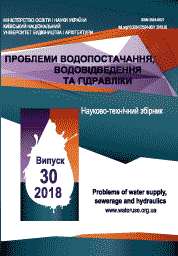Ferrit cleaning of waste water from zinc ions: influence of aeration rate
DOI:
https://doi.org/10.32347/2524-0021.2018.30.14-22Ключові слова:
ferritisation, wastewater treatment, aeration, sediments, zink compoundsАнотація
The current work is devoted to development and improvement of integrated water treatment technologies, which provide both high efficiency removal of contaminants with small level of resource consumption. The influence of air flow on the process of ferrite treatment for concentrated zinc-containing wastewater of galvanic facilities has been investigated. The dependence of the efficiency of heavy metal ions extraction on aeration rate was determined. The most effective results of wastewater treatment are achieved at small values of aeration rate. The efficiency of removal for ferrum ion has reverse dependence and increases with growing of air flow. The influence of the oxidant amount on the structure of sediments after ferritinization treatment has been studied. The sediments are chemically stable, have a dense crystalline structure and ferromagnetic properties. On the basis of experimental researches, the best aeration rate for the ferritization process has been determined, which allows to rational use of electric energy in the technological scheme of ferrstization process. The directions of further researches for wastewater treatment of zinc galvanic lines are to achieve of maintenance for all necessary parameters of water quality for closed circuit water supply systems.Посилання
Kochetov, G. (2008). Development of a system of cleaning of washing waters of electroplating manufactures. Problems of water supply, sewerage and hydraulic, 10. 73-78.
Rubanov, Yu. K., Tokach, Yu. E., Nechaev, A. F. & Ognev, M. N., (2009). The galvanic productions waste waters and sludges processing with the heavy metals ions extraction. European Journal of Natural History, 6, 79-80.
Fu, F., Qi, W., (2011). Removal of heavy metal ions from wastewaters: a re-view.. J. Environ. Manag., 92(3), 407-418. doi:doi.org/10.1016/j.jenvman.2010.11.011
Hsing-Cheng, L., Juu-En, C., Pai-Haung. S. & Li-Choung. C., (2008). Stabilization of copper sludge by high-temperature CuFe2O4 synthesis process. Journal of Hazardous Materials, 150(3), 504-509. doi:10.1016/j.jhazmat.2007.04.130
Tu, Y.J., Chang, C.K., You, C.F. & Wang, S.L., (2012). Treatment of complex heavy metal wastewater using a multi-staged ferrite process. J. Hazard. Mater., 209, 379-384.doi:10.1016/j.jhazmat.2012.01.050
Kochetov, G., Prikhna, T., Kovalcheuk, O. & Samchenko, D., (2018). Research of the treatment of depleted Nickel-plating electrolytes by the ferritization method. East-European jornal of enterprise technologies, 93, 54-59. doi:10.15587/1729-4061.2018.133797
Heuss-Aßbichler, S., John, M., Klapper, D., Bläß, U. W. & Kochetov, G. (2016). Re-covery of copper as zero-valent phase and or copper oxide nanoparticles from wastewater by ferritization. Journal of Environmental Management., 33-41. doi:10.1016/j.jenvman.2016.05.053
Singh, P., Payal, R. S., Srivastava R. C., Agrawal, H. M., Chand, Prem, Tripathi, Amita, & Tripathi, R. P., (2010). Effect of thermal treatment on the magnetic properties of nanostructured zinc ferrite. Journal of Physics: Conference Series. 217. doi:10.1088/1742-6596/217/1/012108
Bowles, J. (1997). R.M. Cornell and U. Schwertmann The Iron Oxides: Structure, Properties Reactions Occurrence and Uses. Weinheim and New York (VCH Verlagsgeseiischaft mbH). Mineralogical Magazine, 61(408), 740-741. doi:10.1180/minmag.1997.061.408.20
Tokach, Y. E., Rubanov, Y. K., Pivovarova N. A., Balyatinskaya & L. N., (2013). Galvanic Sludge Recycling with the Extraction of Valuable Components. Middle-East. Journal of Scientific Research, 18(11). 1646-1655. doi:10.5829/idosi.mejsr.2013.18.11.70119
Vinogradov, S. S. (1998). Ecologically safe galvanic production. Issue 3. Moscow: Globus. [in Russian]
Naumenko, І., Кochetov, G. & Іschchenko, N., (2014). Resource-saving processing of liquid wastes containing zinc, ferrite method. Problems of water supply, sewerage and hydraulic, 22. 119-125. [in Ukrainian]
Кochetov, G. & Оleksandrenko, О. (2016). Improvement of the purification of spent electrolytes by chromatating by ferritization. Problems of water supply, sewerage and hydraulic, 27, 207-210. [in Ukrainian]
Zhuravlev, G. (1970). Chemistry and technology of ferrites. L.: Chemistry. 192. [in Russian]
Shluger, M. A., Tok, L. D. (Eds.) (1985). Electroplated coatings in mechanical engineering. Reference in 2 volumes. Volume 2.: "Mechanical Engineering" Moscow. [in Russian]
GOST 9.314-90 (1990). Unified system of protection against corrosion and aging. Water for electroplating and washing schemes. General requirements Moscow.: Izd. Standards. 16. [in Russian]
Gunjakar, J. L., More, A. M., Gurav, K. V. & Lokhande, C. D., (2008). Chemical synthesis of spinel nickel ferrite (NiFe2O4) nano-sheets. App Surf Sci., 254, 5844-5848. doi:10.1016/j.apsusc.2008.03.065
Кolodko, А., Кochetov, G., Samchenko, D. & Pasko, А., (2017). Study of the stability of industrial wastewater treatment waste in alkaline cements. Problems of water supply, sewerage and hydraulic, 28, 180-186. [in Ukrainian]
Kryvenko, P., Cao, H., Petropavlovskyi, O., Weng, L. & Kovalchuk, O., (2016). Applicability of alkaliactivated cement for immobilization of lowlevel radioactive waste in ion-exchange resins. Eastern European Journal of Enterprise Technologies. 1(6). 40-45. doi:10.15587/1729-4061.2016.59489
Krivenko, P., Kovalchuk, O. & Pasko, A., (2017). Utilization of industrial waste water treatment residues in alkali activated cement and concretes. Key Engineering materials, 761, 35-38. doi:10.4028/www.scientific.net/kem.761.35
##submission.downloads##
Опубліковано
Як цитувати
Номер
Розділ
Ліцензія
Автори, які публікуються у цьому журналі, погоджуються з наступними умовами:
a) Автори залишають за собою право на авторство своєї роботи та передають журналу право першої публікації цієї роботи, яка через 70 років після смерті останнього співавтора з дати публікації автоматично стає доступною на умовах ліцензії Creative Commons Attribution License, котра дозволяє іншим особам вільно розповсюджувати опубліковану роботу з обов'язковим посиланням на авторів оригінальної роботи та першу публікацію роботи у цьому журналі.
b) Автори мають право укладати самостійні додаткові угоди щодо неексклюзивного розповсюдження роботи у тому вигляді, в якому вона була опублікована цим журналом (наприклад, розміщувати роботу в електронному сховищі установи або публікувати у складі монографії), за умови збереження посилання на першу публікацію роботи у цьому журналі.
c) Політика журналу дозволяє і заохочує розміщення авторами в мережі Інтернет (наприклад, у сховищах установ або на особистих веб-сайтах) рукопису роботи, як до подання цього рукопису до редакції, так і під час його редакційного опрацювання, оскільки це сприяє виникненню продуктивної наукової дискусії та позитивно позначається на оперативності та динаміці цитування опублікованої роботи (див. The Effect of Open Access).


